|
|
|
Sort Order |
|
|
|
Items / Page
|
|
|
|
|
|
|
| Srl | Item |
| 1 |
ID:
155330
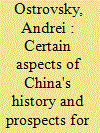

|
|
|
|
|
| Summary/Abstract |
The author examines issues of and prospects for China's innovative development, the formation processes of the strategy of introduction of the advanced world experience as well as new scientific and technological innovations during the past seven five-year-plan periods (from 1981 to 2015). The article assesses plans and prospects of scientific and technological development in the 13th five-year-plan period (2016-2020). It also analyzes the main development trends, problems, and difficulties confronting China along the developmental path toward an innovative economy.
|
|
|
|
|
|
|
|
|
|
|
|
|
|
|
|
| 2 |
ID:
166020
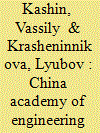

|
|
|
|
|
| Summary/Abstract |
This paper looks at the principal stages in the formation of the China Academy of Engineering Physics, the only organization in that country that is in charge of developing and manufacturing nuclear weapons. The Academy is a relatively little known, yet important and growing component of China's defense-industrial complex (DIC). Nuclear weapons are not its only concern, for it also works on laser weapons, weapons on new physical principles, and some promising lines in civil innovation.
|
|
|
|
|
|
|
|
|
|
|
|
|
|
|
|
| 3 |
ID:
002814
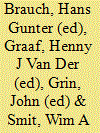

|
|
|
|
|
| Publication |
Amsterdam, VU University Press, 1992.
|
| Description |
xxxix, 406p.,tables
|
| Standard Number |
9053581037
|
|
|
|
|
|
|
|
|
|
|
|
Copies: C:1/I:0,R:0,Q:0
Circulation
| Accession# | Call# | Current Location | Status | Policy | Location |
| 034448 | 355.82/BRA 034448 | Main | On Shelf | General | |
|
|
|
|
| 4 |
ID:
143776
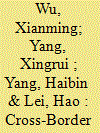

|
|
|
|
|
| Summary/Abstract |
Mixed results from studies on Chinese cross-border mergers and acquisitions (M&As) have been a puzzle for both academia and business professionals over the years. Do these M&As create value when Chinese firms acquire foreign target firms suffering heavy losses and even on the verge of bankruptcy? This article explores the wealth effect of M&As conducted by Chinese firms as well as the relevant factors from the asset-seeking perspective. The authors use 180 M&A cases conducted by listed firms in China between 2002 and 2012 as samples and examine their wealth effects in a method of event study. The results show that these M&A activities have produced significant positive wealth effects during the event window of [–10, 10]. The authors then study the key factors affecting wealth effects. The findings reveal that an acquiring firm’s strength via research and development (R&D) and M&A experience generates significant positive impacts on the wealth effect. The findings also reveal that an innovation orientation and development stage of host countries helps create positive wealth effects; vertical M&As are particularly favored by the market since they can gain easier access to R&D, marketing channels or mineral resources.
|
|
|
|
|
|
|
|
|
|
|
|
|
|
|
|
| 5 |
ID:
164526
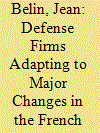

|
|
|
|
|
| Summary/Abstract |
The structural changes inside the French innovation system have impacted the role of defense firms since the late 1980s. Major changes have affected the defense budget and public R&D funding system in particular. The aim of this article is to understand French defense firms’ repositioning within the National Innovation System (NIS) based on an analysis of their R&D behavior over a long period of time (1987–2010). We show that French defense firms remain major players in the NIS and faced up to these major changes by adapting the funding of their R&D and their research priorities and rolling out new innovation capabilities. Additionally, they developed new innovation models to take advantage of new collaborative partnerships developed for civil and military markets.
|
|
|
|
|
|
|
|
|
|
|
|
|
|
|
|
| 6 |
ID:
182631
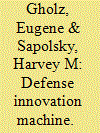

|
|
|
|
|
| Summary/Abstract |
American security policy discussions commonly warn that the United States is falling behind technologically, especially vis-à-vis China. However, the U.S. military remains at the cutting edge because of its well-developed defense innovation system. No nation (or combination) comes close to U.S. investment in defense R&D. Unmatched political concerns about avoiding casualties, inherent rivalry among participants in the U.S. defense innovation system, and traditional American openness to immigration and new ideas drive the investment. The overly alarmist warnings come from a thriving threat assessment system that continually searches for potential military dangers and technological challenges. The warnings feed the defense innovation system.
|
|
|
|
|
|
|
|
|
|
|
|
|
|
|
|
| 7 |
ID:
182752
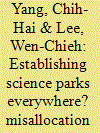

|
|
|
|
|
| Summary/Abstract |
The establishment of science parks is a vital strategy to develop high-tech industries and facilitate innovations in China. The success of a science park depends heavily on its supportive environment, suggesting that it is hard to replicate everywhere, while China has established many science parks across regions in the past decade. This study evaluates the degree of misallocation in research and development (R&D) and its determinants across science parks in China. Based on an unbalanced panel data of 145 science parks for the period 2007–2014, we find that the overall R&D efficiency has decreased sharply since 2011 when China began to initiate many new science parks. The newly constructed science parks exhibit a lower R&D efficiency than their incumbent parks, suggesting a considerable misallocation in R&D resource caused by expanding science parks everywhere. We further investigate the determinants of R&D misallocation and find that park characteristics and environmental characteristics matter. Parks which are larger, older, and having a higher human quality experience a lower R&D misallocation. Parks with closer R&D collaboration with universities or research institutes, particularly with universities, exhibit a lower R&D misallocation.
|
|
|
|
|
|
|
|
|
|
|
|
|
|
|
|
| 8 |
ID:
004373
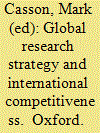

|
|
|
|
|
| Publication |
Oxford, Basil Blackwell, 1991.
|
| Description |
vii,312p.
|
| Standard Number |
0631180230
|
|
|
|
|
|
|
|
|
|
|
|
Copies: C:1/I:0,R:0,Q:0
Circulation
| Accession# | Call# | Current Location | Status | Policy | Location |
| 035067 | 338.926/CAS 035067 | Main | On Shelf | General | |
|
|
|
|
| 9 |
ID:
190452


|
|
|
|
|
| Summary/Abstract |
Greece was never internationally renowned for its defence industry; in fact, its state-owned industries were usually a source of headaches rather than income for Athens. The Debt Crisis (2008-18) compounded the chronic ills of the Greek defence ecosystem which appeared to decline irreversibly. And yet, in recent years they rebounded and reached new heights. How can this surprising turnaround be explained? And what does it indicate for the future of the Greek defence industry? This paper aspires to examine how the Greek defence ecosystem (state- and private-owned) evolved from a stage of stagnation and decline into a phase of stabilisation.
|
|
|
|
|
|
|
|
|
|
|
|
|
|
|
|
| 10 |
ID:
015587
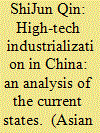

|
|
|
|
|
| Publication |
Dec 1992.
|
| Description |
1124-1136
|
|
|
|
|
|
|
|
|
|
|
|
|
|
|
|
| 11 |
ID:
170781
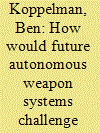

|
|
|
|
|
| Summary/Abstract |
Autonomy has become a military priority both for R&D and active deployment. However, there are concerns that future autonomous weapon systems might not be safely controlled. Ben Koppelman explains these concerns by exploring how future systems would challenge fundamental norms that govern current systems, especially the need to facilitate compliance with international humanitarian law. The article also considers how to tackle these challenges if these future systems are to be deployed safely.
|
|
|
|
|
|
|
|
|
|
|
|
|
|
|
|
| 12 |
ID:
159051
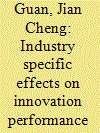

|
|
|
|
|
| Summary/Abstract |
This research aims to understand how industrial characteristics in Chinese industrial sectors are related to and affect innovation activities. Using Heckman's two-step procedure, this study contributes to examine firms' innovation determinants with a framework that clearly distinguishes between the two steps of innovation model: innovation propensity (probability of being innovative) and innovation performance (patents and innovation sales). In particular, the moderating effects of industrial characteristics on the relationships between R&D intensity, financial incentives and innovation performance are discussed. The findings show that different industrial characteristics generate different impacts on innovation propensity and innovation performance. Firms in capital intensive industries and relative monopoly industries are more likely to innovate. The findings also show that Direct Government Subsidy does not contribute significantly to improve economical innovation performance of firms and Indirect Government Subsidy on innovative economic performance is easier to be influenced by industry characteristics, which have important potential policy implications to guide innovation activities for Chinese policy makers as well as for Chinese firms.
|
|
|
|
|
|
|
|
|
|
|
|
|
|
|
|
| 13 |
ID:
124554
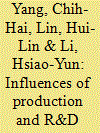

|
|
|
|
|
| Publication |
2013.
|
| Summary/Abstract |
As China adopts a government-supported agglomeration model to develop high-tech industries, it is crucial to examine whether the spatial concentration of manufacturing and R&D activities enhance firm-level productivity. Based on a panel dataset of Chinese electronics firms from 2005 to 2007, the calculated Ellison-Glaeser (EG) index indicates that both production and R&D activities are highly spatially concentrated. Crucially, we find that production agglomeration has a positive relationship with firms' productivity, especially for smaller firms. In contrast, R&D agglomeration seems to negatively relate with productivity. It implies that the possible congestion effect and/or free rider problems erode the benefit derived from knowledge spillovers.
|
|
|
|
|
|
|
|
|
|
|
|
|
|
|
|
| 14 |
ID:
143374
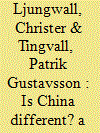

|
|
|
|
|
| Summary/Abstract |
In this paper we examine whether China has benefited more from spending on R&D than other countries by conducting a meta-analysis of the relevant literature on a large number of countries at different stages of economic development. The results suggest that the growth-enhancing effect of R&D spending in China has been significantly weaker than that of other countries. It is thus unlikely that R&D spending has been successful as a key contributing factor to economic growth in China.
|
|
|
|
|
|
|
|
|
|
|
|
|
|
|
|
| 15 |
ID:
161769
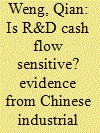

|
|
|
|
|
| Summary/Abstract |
We hypothesize that research and development (R&D) is sensitive to cash flow fluctuations due to asymmetric information and agency problems in the credit market. We adopt a variant of the Q model for R&D investment using the value of the firm, physical capital and employment to capture firm fundamentals as proxies for investment opportunities. We add cash flow to this specification, and estimate the augmented model separately for R&D participation and spending decisions using data on Chinese industrial firms for the period 2001–2006. We find that R&D participation and spending are sensitive to cash flow fluctuations, conditional on firm fundamentals. We also find that the cash flow sensitivity of R&D varies across firms depending on ownership.
|
|
|
|
|
|
|
|
|
|
|
|
|
|
|
|
| 16 |
ID:
141698
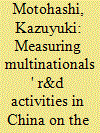

|
|
|
|
|
| Summary/Abstract |
Using an internationally linked patent database, this paper compares the types of R&D activities undertaken by multinationals in China by home country and industry. In China, multinationals recently began investing in R&D, mainly in the areas of product and manufacturing process development. However, US firms, which are the most actively invested in R&D, are involved in some technology-driven R&D activities; European firms are inclined toward market-driven R&D, while Japanese firms, which lag behind the other two, focus on production-driven R&D. This pattern may be related to the relative competitiveness of each country: Japanese firms are strong in electronics and automobiles, where production process improvement is important, while US firms flourish in science-based industries, such as pharmaceuticals and software, where interacting with the local science base is a critical factor.
|
|
|
|
|
|
|
|
|
|
|
|
|
|
|
|
| 17 |
ID:
192046


|
|
|
|
|
| Summary/Abstract |
Modern countries employ computer networks that manage organizations in the private and public sectors. Cyber-attacks aim to disrupt, block, delete, manipulate or steal the data held in these networks, which challenge these countries’ national security. Consequently, cybersecurity programs must be developed to protect these networks from cyber-attacks in a manner that is similar to operations against terrorism. This study presents several models that analyze a contest between a network operator (defender) that deploys costly detectors to protect the network and a capable cyber attacker. Generally, when the deployed detectors become more potent or the defender exhibits higher vigilance, the attacker allocates more resources to R&D to ensure that the attack remains covert. We show that detectors may be substitutes, complements, or even degrade each other, implying that defenders must account for the cyber weapons’ characteristics and the attacker’s profile and strategic behavior. We derive the optimal number of detectors when the attacker’s R&D process features R&D spillovers and show that targeted detectors act as deterrents against high-quality weapons only if the attacker’s budget is not substantial. Finally, we demonstrate that common cybersecurity practices may be detrimental from a social-welfare perspective by enhancing an arms race with the attacker.
|
|
|
|
|
|
|
|
|
|
|
|
|
|
|
|
| 18 |
ID:
190398
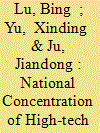

|
|
|
|
|
| Summary/Abstract |
Based on the product-country level trade data from 2004 to 2017, as well as the High-Tech Products Catalog from the US Census Bureau, this paper examines empirically the current phenomenon of “national concentration” in high-tech exports. The results show that the phenomenon of “national concentration” not only exists but also tends to be self-reinforcing. Compared with other products, the exports of high-tech products tend to be concentrated in certain countries, and this concentration trends were further strengthened after the global financial crisis of 2008–2009. The national concentration of R&D activities may be one of the important causes of the national concentration of high-tech products. This pattern remains robust when we further use the value-added export data and different definitions of high-tech products. We argue that the phenomenon of “national concentration” of high-tech exports may herald the arrival of the “Second Great Divergence” – the divergence between innovative and manufacturing activities – in the global economy.
|
|
|
|
|
|
|
|
|
|
|
|
|
|
|
|
| 19 |
ID:
177141
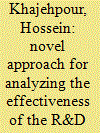

|
|
|
|
|
| Summary/Abstract |
Limited access to energy resources and increasing demand for mitigation of the environmental impacts have necessitated higher production efficiencies. Therefore, the promotion of R&D activities has been one of the main parts of national energy policies. In this research work, two methods are used for assessing the effectiveness of the R&D capital on resource conservation. First, by developing the resource-included knowledge production function of the energy sector and second, through direct assessment of the functionality of resource productivity from R&D capital. Based on official data provided by national statistical centers, a comparative analysis has been conducted to examine the effectiveness of R&D in the electricity generation sectors in the United Kingdom and Germany. In these analyses, non-renewable exergy cost is used as an index of resource depletion and environmental burden. It is shown that, due to non-economic energy transition policies, the inclusion of the R&D investment does not result in statistically meaningful elasticity of production for the R&D capital. However, according to the second method, it is shown that the R&D investment in the United Kingdom has been more effective in resource conservation than in Germany. Possible reasons for such differences are discussed and recommendations for further investigations are presented.
|
|
|
|
|
|
|
|
|
|
|
|
|
|
|
|
| 20 |
ID:
072107
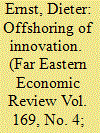

|
|
|
|
|
|
|
|